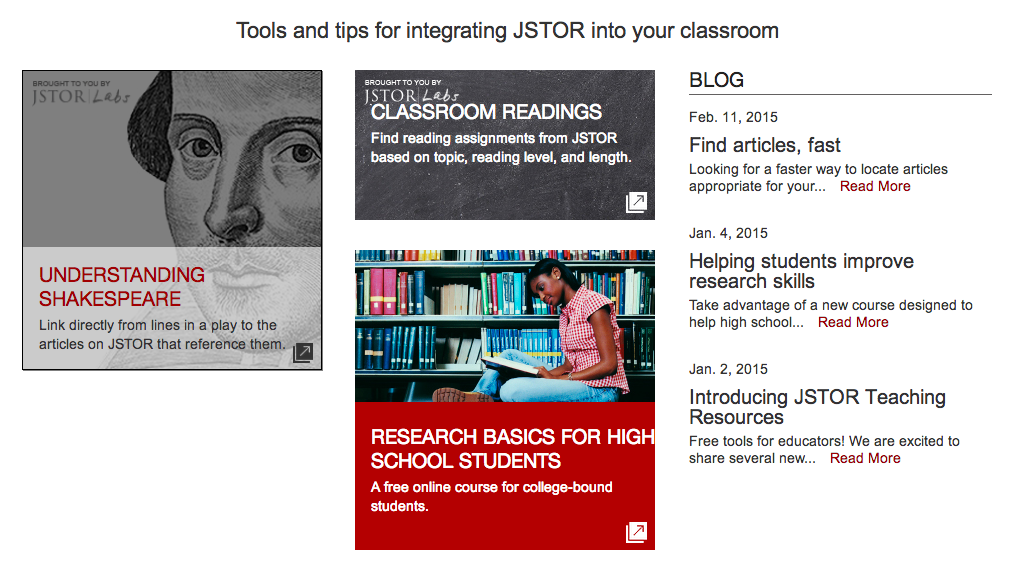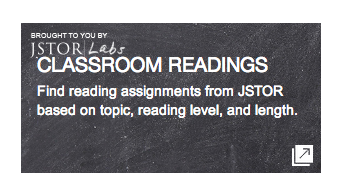Using JSTOR's Teaching Resources In Your (English) Classroom
It Started with an Email...
I recently received an email from JSTOR announcing their new Teaching Resources, an email I am so happy to have received! I developed the curriculum for my AP Literature and Composition course, a senior English class, last spring, and in several units, I linked to JSTOR as a resource. The only caveat: in order for students (or you) or me to access the articles, you have to register for free AND you can only have three articles on your book shelf at a time AND of course there is a limit to how often you can switch these articles out. Although students found it tricky at times to get registered and to add items to their bookshelves, these articles are an amazing resource in a course asking students to learn to do some heavy thinking, thinking about and with literature in ways they never knew possible, especially given that I created my own online "textbook" using Haiku, teaching my course as a hybrid course, one with face-to-face and online, synchronous and asynchronous components.
But Really, It Started in Graduate School
I fell in love with the research I was able to do using the technology available to me in the late 90s as an undergraduate, but by the time I was a graduate student in the early 2000s, technology had expanded so much and I was ecstatic about the sheer amount of quality information I could find without leaving my house. As a high school English teacher, I was frustrated because my students did not have the same access to JSTOR and other such academic databases as I did as a student at Appalachian State University, and so I began searching for ways to help them research better and research better online while simultaneously and continuously searching for new online resources for research. EBSCOhost was an early resource available to public school teachers. And now....JSTOR has made some resources available to us as well!
About JSTOR and Why They Provide These Resources To Educators
"The sheer volume of online content available today can be challenging to explore and integrate into the classroom. JSTOR alone is an online library of more than 2,000 full-text academic journals, 30,000 books, and millions of primary sources. The purpose of JSTOR Teaching Resources is to help educators to get the most out of JSTOR and other academic resources.
The resources highlighted on this site include both stand-alone modules designed to build students’ academic research skills and experimental tools intended to help teachers and students navigate academic content as efficiently as possible. We also include insights from the staff designing the resources, examples from people using the tools, and pointers to complementary sites" (from JSTOR's Teaching Resources "About Me" page).
Ways I Have Used JSTOR In My AP English Class
We are (still) in Unit One at the moment (due to snow), a unit I designed after a careful study of the College Board's AP material for this course and its sister course, AP Language and Composition. Last year, JSTOR's Teaching Resources did not exist; however, I linked to some literary criticism articles I found on JSTOR's website, asking students to read and annotate these after having read the related short story, before being asked to apply that critical lens in an essay of their own writing.
How I Will Use JSTOR's Teaching Resources in My AP English Classes
This new resource still has the same amazing content and more, but now it is even more accessible, and given that I am still in unit one, it couldn't have come at a better time. I am enjoying making these resources a central component of my AP English course. Why? In addition to the classroom readings that are available by topic and free to read online, there are other free tools available for educators and students alike, such as Research Basics for High School Students: A free online course for college bound students, a blog that provides tips on making the most of these resources, and the feature I may be most excited about, Understanding Shakespeare which links "directly from lines in a play to the article on JSTOR that reference them" (TeachJSTOR.org, n.p.).
- To Teach the Art of (Various) Literary Criticism(s)
So, how will I use these resources? Browsing the section entitled Classroom Readings, I found some literary criticisms that align perfectly with unit 1 of my AP Literature and Composition course, "Seeing/Ways to "See" Literature" and I added them into the unit, building on the two feminist criticism essays related to Charlotte Gilman's "The Yellow Wallpaper" that I already ask students to read. To see how I embed these resources in the summative assessment, see my earlier post, "Applying a Critical Lens" (March 3, 2015).
- To Teach the Art of Research
I plan to use Research Basics for High School Students by embedding it on Haiku, the course delivery system we use in our district. I do have the luxury of working at a one-to-one laptop school, and I know I take the ease with which I make use of new resources and my students' connectivity for granted. I am going to use this free online course as a source for mini-lessons, combined, of course, with my own, during Writer's Workshop, the portion of class certain days a week during which students write and learn about writing in a collaborative environment (writing circles). As I explore this resource more and try it out with my students, I will report back to you and I will come back and update this post with relevant links, and I ask you to report back to us here on how you have used these resources in your classroom.
- To Teach About Shakespeare
See the last sentence above. I have an upcoming unit involving Hamlet with both my English IV and my AP Literature and Composition classes, although the focus of each study is slightly different. As I get closer to teaching those units, I will explore the Understanding Shakespeare resource more in-depth and then try it out in my classroom, and I will be sure to let you know how it goes. After all, I believe teaching is as much an art as a science and the key to perfecting both is routine, deep, methodological, analytical reflection. Also, the Classroom Readings resource contains readings on Hamlet, and I am most excited to extend my students learning of critical lenses as we also fine-tune our knowledge of the genre of drama--its defining characteristics and features, how to read plays and understand them (text features like stage directions), and of course, key playwrights and plays.
A Site Tutorial For Those That Need It (Because You Can't Underestimate the Value of Good Online Navigational Skills)
To access Classroom Readings, from the home page of Teaching Resources (pictured below),
- click on the link that says "Classroom Readings" (pictured below).
2. From there, you will be taken to the screen you see below.
3. Click on "QuickLists by Theme" to search categorically, or type in the search bar to find the quality nonfiction resources you are looking for to align your curriculum to the Common Core.
Common Core Sidebar: Disciplinary Literacy
As you know, a major shift between old state curricula and the new Common Core State Standards for English Language Arts was to focus more on non fiction, which does allow for students to get more practice reading for information (research shows that humans tend to have an inherent story grammar learned from all of our exposure to narrative) as well as allowing for more cross-curricular integration, making interdisciplinary units more feasible and more practical and showing good faith to those other content area teachers asked (forced?) to teach content area literacy known as disciplinary literacy under the Common Core. Also, it is easier than ever and even more important to integrate current events into our curricula to create globally aware students, so what better way to kill a few birds with one metaphorical stone--NON-FICTION!
Please remember that in all things, moderation is key, and the same holds true for the English Language Arts classroom. It is important to maintain a good balance of nonfiction and fiction. But I digress...
But Since We Are Talking About Disciplinary Literacy...
This resource is NOT just for English teachers. Any high school teacher who is teaching research skills (which should be all of us) will find the online research class helpful. There are articles and readings for many disciplines. And with the Common Core State Standards literacy strand, all teachers are tasked with teaching literacy. These resources will help you meet those goals. And good teaching is good teaching. We know that the more we expose students to text across a variety of contexts (especially instructional level text or properly scaffolded, more difficult readings), the better a student becomes at reading and comprehension as they begin to acquire the nonfiction equivalent of a story grammar, becoming proficient in reading for information. So why not help your students become more literate?
Final Thoughts (For Now)
 |
| screen shot |
I assume that more topics will be forthcoming based on the message below, a screen shot I took from within the "QuickLists by Theme" menu. I hope that teachers will be able to submit lesson plans and other resources, including reflections such as this one, through this site. I am excited about the possibilities this resource offers, and I look forward to exploring these possibilities with my students. And no, I have no affiliation with JSTOR, although I will gladly accept free gifts. :)
Yours in Education,
B. Faulkner


